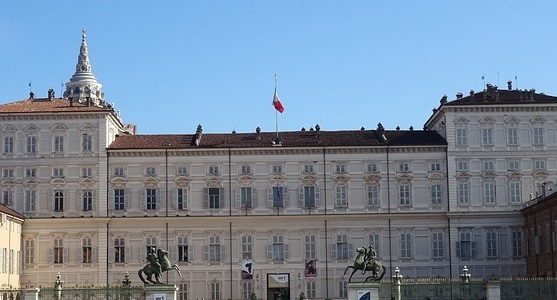
Royal Palace – The Scissors Staircase
The Royal Palace of Turin is the first and most important of the Savoy residences in Piedmont. It was the theater of the politics of the Savoy States for at least three centuries.
The Palace, intended as a ducal residence, was designed between the end of the 16th century and the beginning of the 17th century by Ascanio Vittozzi. At the death of the latter, during the regency of Christine of France, the baton passed to Amadeo di Castellamonte. Subsequently, the facade of the building took on its present appearance, according to the seventeenth-century project of Carlo Morello. The characteristic central part appeared, flanked by two higher wings. Inside, however, the rooms of the main floor were decorated with allegorical images celebrating the royal dynasty. These are splendid works of art created by the hands of various artists.
In the course of time, great names gave their contribution to the magnificence of this building. At the end of the seventeenth century, for example, Daniel Seiter frescoed the ceiling of the Gallery, later called the Daniel Gallery. Guarino Guarini, on the other hand, built the Chapel of the Holy Shroud to house the precious relic. In the eighteenth century, then, it was decided to call for some changes to the famous architect Filippo Juvarra. Now there are many interesting anecdotes about the Royal Palace. But there is a very famous one that concerns this architect.
In spite of the trust immediately shown to him by the king, Vittorio Amedeo II, on his arrival in Turin, the Savoy family did not like him. Juvarra was considered a bit too original.
However, in 1720, on the occasion of the wedding of the crown prince, Juvarra had an open confrontation. Juvarra proposed the construction of a daring pincer staircase to connect two floors of the Royal Palace. The proposal was met with hostility. But the architect did not want to give up and realized the staircase anyway. Before completing his work, however, he had a medallion decorated with scissors placed at the convergence of the pincer. Its meaning? It was a clear allusion to the evil tongues that had disparaged him.
Centuries later, the “scalone delle scissors” continues to amaze even today for its beauty.
Did you like this curiosity? If you want to read more, about thousands of cities, download Secret Maps!
And if you want to listen to something interesting, try the first Travel Podcast Platform. Try Loquis!

